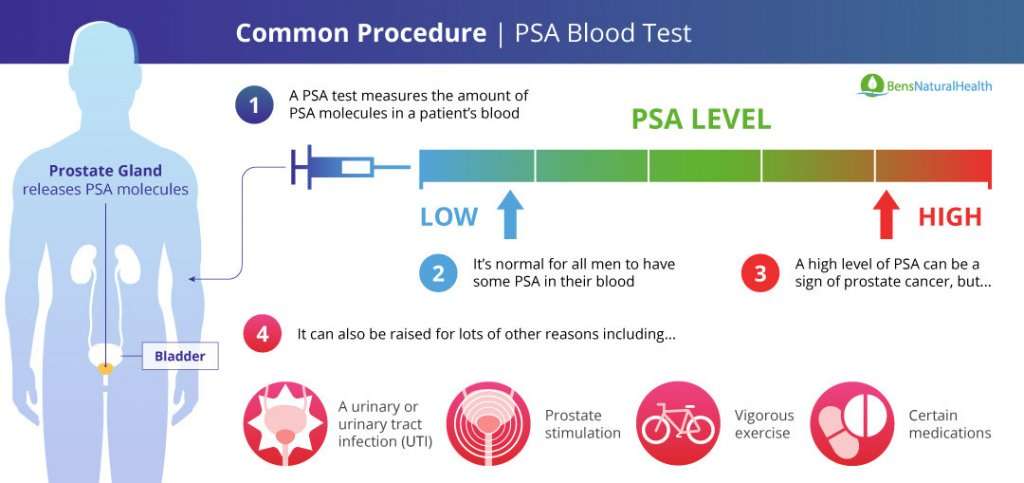Reasons for Frequent UTIs: When Urinary Tract Infections Keep Coming Back
Why do some women get recurrent urinary tract infections (UTIs)? Discover the common reasons behind recurring UTIs and effective strategies to prevent them.
Recurrent UTIs: Understanding the Underlying Causes
Urinary tract infections (UTIs) are a common health issue, particularly for women. While most UTIs can be effectively treated with antibiotics, some individuals experience a frustrating pattern of recurrent infections. In fact, up to 30% of women who have had a UTI will experience a recurrence within six months. This begs the question: Why do some women struggle with recurring UTIs?
Anatomy and Genetics: Risk Factors for Recurrent UTIs
One of the primary reasons why women are more prone to UTIs, including recurrent ones, is their anatomy. The female urethra is significantly shorter than the male urethra, making it easier for bacteria to enter the urinary tract. Additionally, the close proximity of the urethra to the vagina and anus increases the risk of bacteria spreading from these areas into the urinary system.

Genetics also play a role in UTI susceptibility. Women with a family history of recurrent UTIs are more likely to experience the same issue. This suggests that certain genetic factors may predispose some individuals to more frequent urinary tract infections.
Hormonal Changes and Vaginal Health
Hormonal changes, particularly those that occur during and after menopause, can contribute to recurrent UTIs in women. As estrogen levels decline, the number of beneficial Lactobacilli bacteria in the vagina also decreases. This can lead to an overgrowth of harmful bacteria, like E. coli, that are more likely to cause infections.
Additionally, the bladder’s ability to contract and fully empty may become less effective with age, making it more challenging to flush out bacteria and prevent infections.
Sexual Activity and Contraceptive Use
Sexual intercourse is a well-known risk factor for UTIs, as it can introduce bacteria into the urinary tract. This is particularly true for women who use spermicides, which may kill off beneficial vaginal bacteria and create an environment more susceptible to E. coli overgrowth.
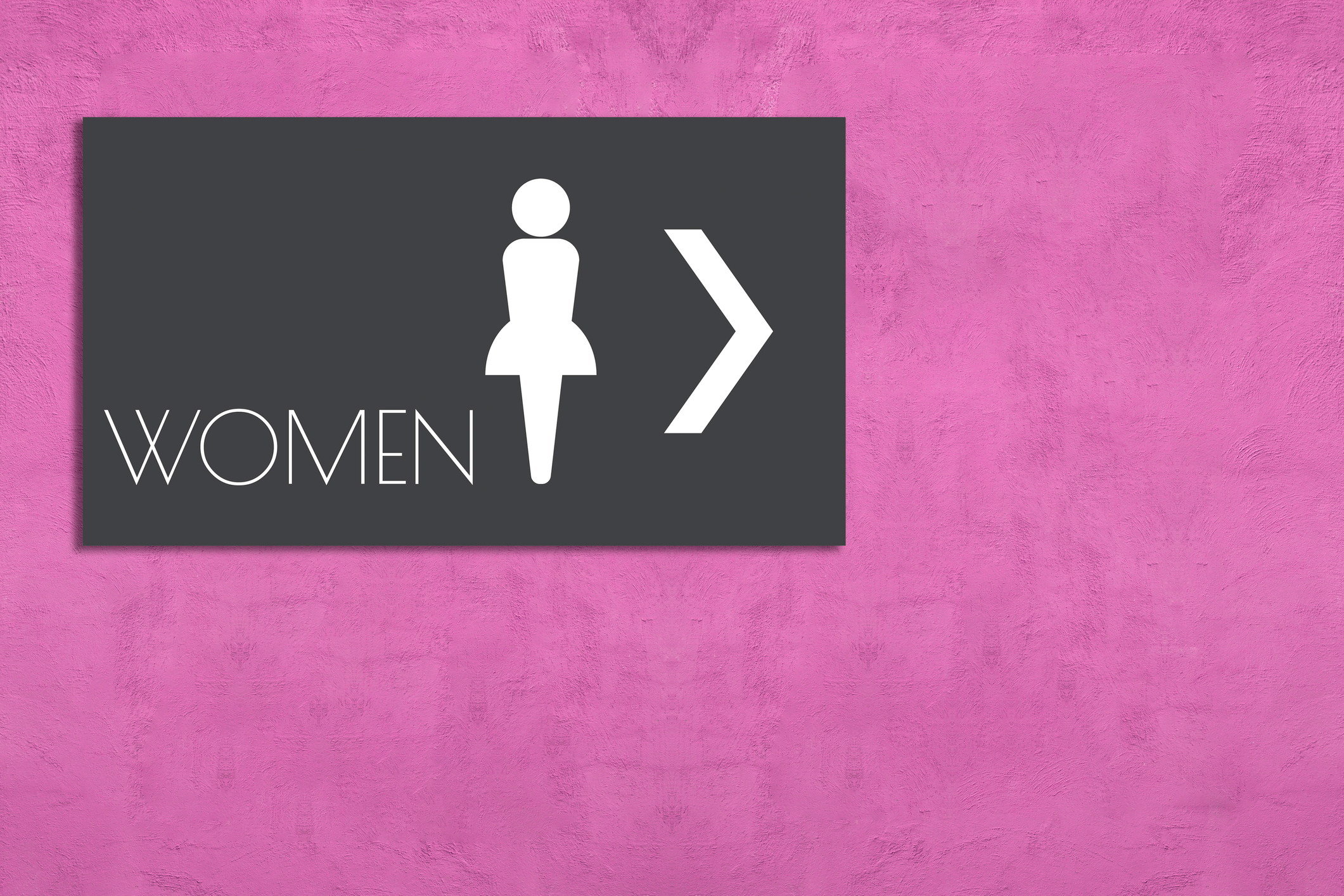
To reduce the risk of UTIs associated with sexual activity, it is recommended to urinate before and after intercourse to help flush out any bacteria that may have entered the urethra.
Antibiotic Resistance and Ineffective Treatment
In some cases, recurring UTIs may be the result of antibiotic resistance. If the same antibiotic is used repeatedly to treat infections, the bacteria responsible for the UTI may develop resistance to that particular medication, making it less effective in subsequent infections.
To address this issue, healthcare providers may recommend rotating between different antibiotics or trying alternative treatment approaches, such as low-dose daily antibiotic prophylaxis or the use of cranberry supplements.
Preventing Recurrent UTIs: Strategies to Consider
While some risk factors for recurrent UTIs are difficult to control, there are several steps individuals can take to help prevent or manage this frustrating condition:
- Drink plenty of fluids, especially water, to help flush out the urinary system.
- Avoid using spermicides and consider alternative contraceptive methods.
- Urinate before and after sexual activity to help remove any bacteria that may have entered the urethra.
- For postmenopausal women, consider using topical vaginal estrogen therapy to help maintain a healthy vaginal environment.
- Practice good hygiene by wiping from front to back to prevent the spread of bacteria.
- Work closely with a healthcare provider to develop an effective treatment plan, which may include rotating antibiotics or trying alternative approaches.
Takeaway: Addressing the Underlying Causes of Recurrent UTIs
Recurrent UTIs can be a frustrating and disruptive condition, but understanding the underlying causes can help individuals and healthcare providers develop effective strategies to prevent and manage this problem. By addressing factors like anatomy, genetics, hormonal changes, and antibiotic resistance, individuals can take proactive steps to reduce the likelihood of recurring urinary tract infections and improve their overall urinary health.
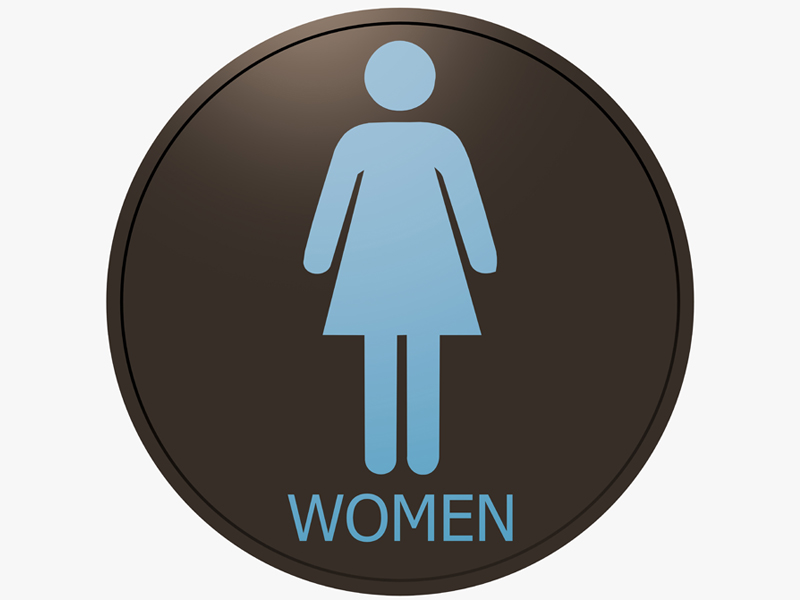
When urinary tract infections keep coming back
If you are prone to recurrent UTIs, you can head them off before they take hold.
Unless you’re in the fortunate minority of women who have never had a urinary tract infection (UTI), you know the symptoms well. You might feel a frequent urgency to urinate yet pass little urine when you go. Your urine might be cloudy, blood-tinged, and strong-smelling. For 25% to 30% of women who’ve had a urinary tract infection, the infection returns within six months.
If you have repeated UTIs, you’ve experienced the toll they take on your life. However, you may take some comfort in knowing that they aren’t likely to be the result of anything you’ve done. “Recurrent UTIs aren’t due to poor hygiene or something else that women have brought on themselves. Some women are just prone to UTIs,” says infectious diseases specialist Dr. Kalpana Gupta, a lecturer in medicine at Harvard Medical School.
Why some women get recurrent UTIs
The infections are usually caused by Escherichia coli, a bacterium that lives in the intestinal system. If E. coli are carried from the rectum to the vagina, they can enter the urethra (the tube that carries urine from the bladder) and infect the bladder.
Risk factors for UTI vary with age. Before menopause, the most common risk factors are sexual intercourse and use of spermicides. It’s thought that sex increases the number of bacteria in the bladder, and many experts advise women to urinate after sex to flush them out. Spermicides may kill off Lactobacilli, beneficial bacteria in the vagina, making it easier for E. coli to move in.
After menopause, certain physical changes help set the stage for UTIs. The numbers of Lactobacilli in the vagina naturally decline. The bladder also contracts less strongly than it once did, making it more difficult to empty it completely.
In both premenopausal and postmenopausal women, genes play a role as well. Having a mother or sister who has frequent UTIs is also a risk factor.
Having a mother or sister who has frequent UTIs is also a risk factor.
Preventing UTIs
These approaches have some evidence to support them:
- Drink plenty of fluids every day. Aim for about 2 to 3 liters.
- Use alternative contraception that does not include a spermicide.
- Empty your bladder immediately following sexual intercourse.
- Consider vaginal estrogen therapy for post-menopausal women.
- Wipe front to back, although this has not been scientifically proven to make a difference.
Antibiotics
Taking a low dose of one of the antibiotics used to treat UTI is the most common way of dealing with recurrences. However, bacteria may become resistant to an antibiotic overtime and it may not be effective in treating subsequent infections. “This is an area in which women can experiment and find which solution works for them,” Dr. Gupta says. There are several options if you have a prescription on hand:
- taking a low dose daily for six months or longer
- using only after you have sex
- waiting until you have UTI symptoms.

If you have recurrent UTIs, talk to your clinician. The two of you can come up with a plan that is likely to be effective for you.
… and it won’t hurt to try these Like many women, you may have memorized the following age-old advice for preventing UTIs:
These suggestions are directed at flushing the bladder and keeping E. coli from spreading into the urinary tract. Although studies have failed to show that they prevent either primary or recurrent UTIs, there’s no harm in trying them, Dr. Gupta says. “They can’t hurt, and if they help, you’re ahead of the game.” |
Image: designer491/Getty Images
4 Reasons Why You Might Get Recurring UTIs
Many women who get a urinary tract infection (UTI) may get one again at some point in their lives. In fact, one in five women experience recurrent UTIs—an infection that occurs two times or more within six months or at least three times in a year. Men can get recurrent UTIs too, but it is not as common and is often due to some type of urinary tract blockage.
In fact, one in five women experience recurrent UTIs—an infection that occurs two times or more within six months or at least three times in a year. Men can get recurrent UTIs too, but it is not as common and is often due to some type of urinary tract blockage.
What Causes Recurring UTIs in Women?
There are many reasons why women may have recurring urinary infections, but we will focus on four common reasons.
1. Anatomy and/or genetics
Women are more prone to UTIs mostly because of their anatomy. A woman’s urethra is shorter than a man’s. Plus it is located near the openings of the vagina and anus, meaning there’s more opportunity for bacteria from both those areas to spread—or be wiped—into the urethra. Once bacteria is in the urethra, it only has a short distance to travel to the bladder and cause an infection.
Additionally, some women have cells that are naturally more receptive to bacteria, meaning the bacteria are less likely to be flushed out by your natural body functions. In a 2009 study of more than 1,200 women who experience recurrent UTIs and kidney infections, researchers determined that a genetic variation in these cell receptors is associated with an increased risk of bladder and kidney infections.
In a 2009 study of more than 1,200 women who experience recurrent UTIs and kidney infections, researchers determined that a genetic variation in these cell receptors is associated with an increased risk of bladder and kidney infections.
2. Bathroom habits
Because a woman’s urethra is so short and so close to the vagina and anus, it’s important to wipe from front to back after going to the bathroom. This lessens the risk of any fecal matter or bacteria being moved from the anus into the urethra. It’s also important to make sure you are clean and dry before pulling your underwear back up. Any fecal matter or bacteria can land on the underwear and spread as the underwear moves as you walk, sit, exercise, etc.
3. Sexual activity
Bacteria can spread more easily during sexual activity, from your partner’s genitals, fingers, tongue or even sex toys. Such activity in that intimate area can also spread your own bacteria from your vagina or anus into your urethra. That’s why doctors tell you to pee after having intercourse or participating in any sexual activity—to help flush any errant bacteria out of the urethra. Practicing good hygiene before and after sexual activity is also helpful. Wash your intimate area as well as your hands and fingers before and after sex. Clean sex toys before and after using as well.
That’s why doctors tell you to pee after having intercourse or participating in any sexual activity—to help flush any errant bacteria out of the urethra. Practicing good hygiene before and after sexual activity is also helpful. Wash your intimate area as well as your hands and fingers before and after sex. Clean sex toys before and after using as well.
Diaphragms, spermicides and condoms may increase your risk for UTI if you are prone to recurrent infections. However, talk to your doctor about solutions. You may be able to go on a low-dose of antibiotics as a preventive measure for six months at a time or after having sex.
4. Other health issues
Having a suppressed immune system or chronic health condition can make you more prone to recurring infections, including UTIs. Diabetes increases your risk for a UTI, as does having certain autoimmune diseases, neurological diseases and kidney or bladder stones. If you’ve had surgery on any part of your urinary tract (urethra, bladder, ureter, kidney), resulting scar tissue or alteration in anatomy could leave you more susceptible to infection.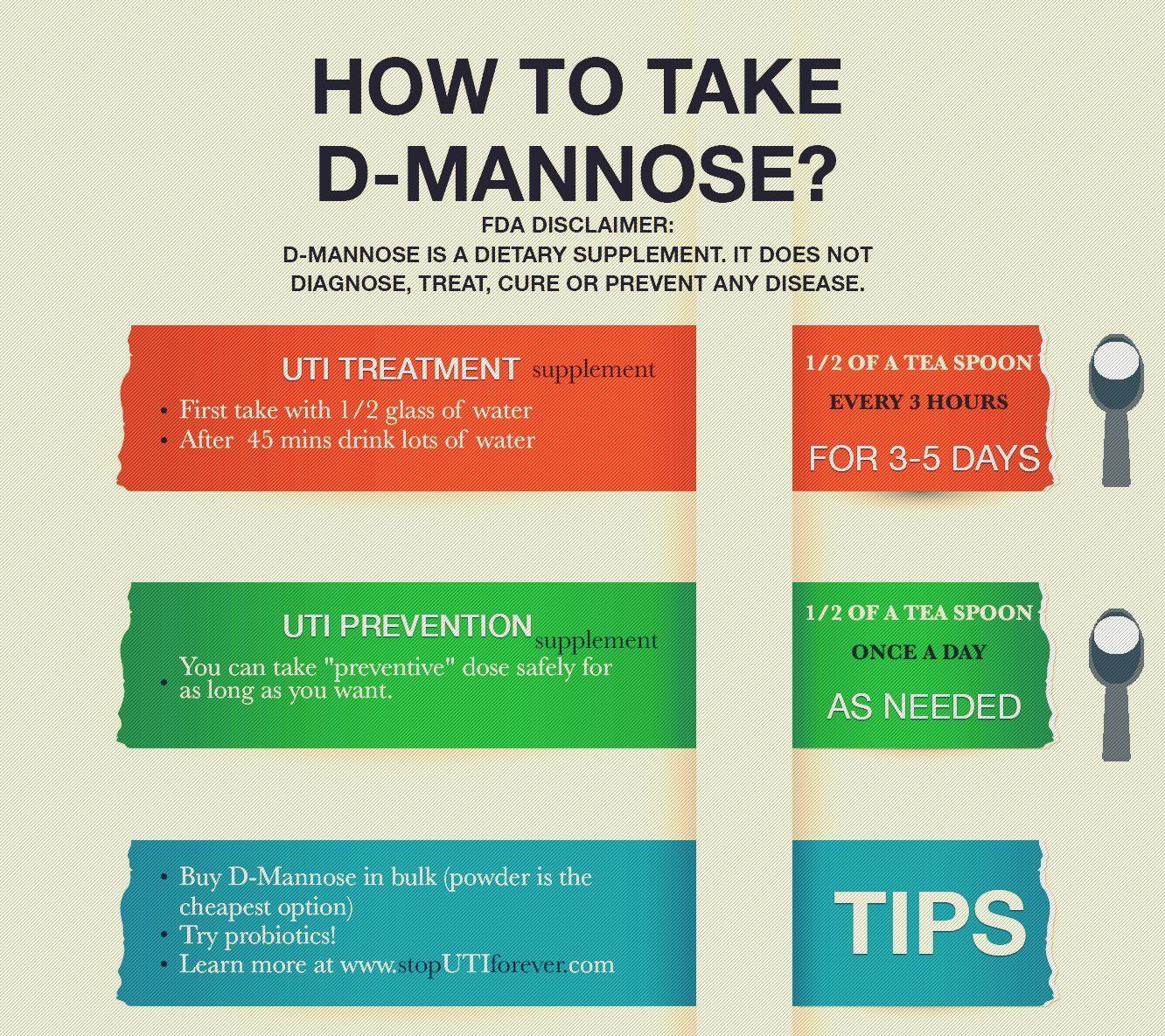
What Can You Do If You Keep Getting UTIs?
If you keep getting UTIs, you must talk to your doctor. After talking with you, your doctor will either recommend treatments for recurring urinary infections or send you to a special doctor called a urologist. A urologist focuses on diseases and problems of the entire urinary system, so he may be able to better pinpoint what is causing your infections and how to treat and prevent them.
In addition to the tips mentioned above, you can also take some other simple steps to help prevent UTIs, such as:
- Drink plenty of water.
- Wear cotton underwear.
- Do not hold pee in—if you have to go, find a bathroom and go.
- Avoid using scented products like sprays, douches and powders that are not gynecologist tested
If you have had a UTI, you know they can be painful. To help with that pain, try Uristat® Pain Relief Tablets. If you have kidney problems or diabetes, talk to your doctor first to make sure this pain reliever is safe for you.
Urinary tract infections: symptoms and treatment
Urinary tract infections (UTIs) cause more than 8 million doctor visits each year and about five percent of all doctor visits. 40 percent of women and 12 percent of men will have at least one episode of a symptomatic urinary tract infection during their lifetime. A bladder infection is called cystitis, and a kidney infection is called pyelonephritis. Kidney infections are much less common but more dangerous.
A few words about the urinary system of a healthy person
The organs of the urinary system form and accumulate urine, which is one of the waste products of our body. Urine is formed in the kidneys and travels down the ureters to the bladder. The bladder serves as a reservoir for storing urine, which is then emptied through the urethra. The urethra ends at the penis in men and the area above the vagina in women.
The kidneys are a pair of fist-sized organs located in the lumbar region that serve as a filter for the body, removing waste products from the body in the form of urine.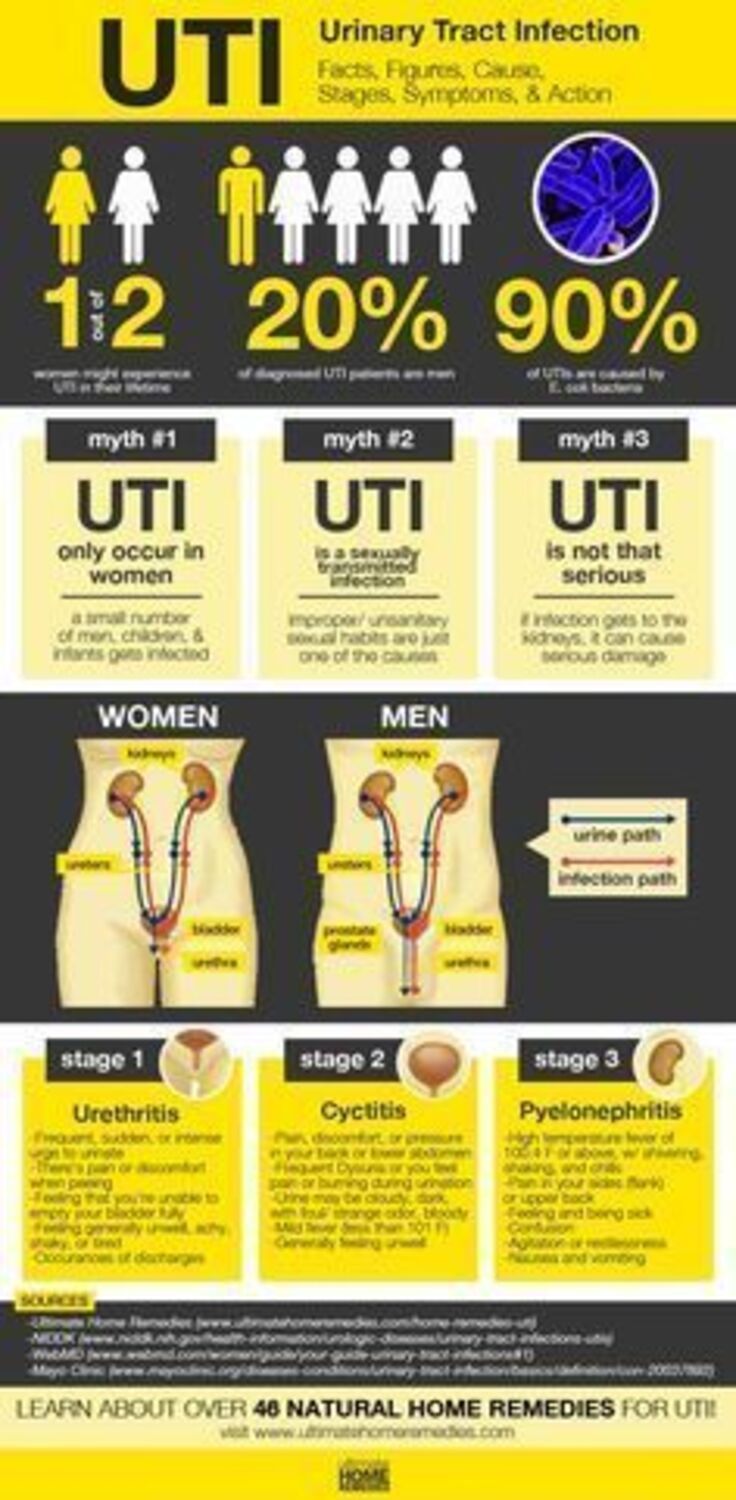 The kidneys also regulate the balance in the body of various chemicals (sodium, potassium, calcium, phosphorus, etc.) and control the acidity of the blood. The kidneys produce certain hormones that are involved in regulating blood pressure, stimulating the production of red blood cells, and promoting the development of strong bones.
The kidneys also regulate the balance in the body of various chemicals (sodium, potassium, calcium, phosphorus, etc.) and control the acidity of the blood. The kidneys produce certain hormones that are involved in regulating blood pressure, stimulating the production of red blood cells, and promoting the development of strong bones.
The ureters are two muscular tubes that transport urine to the bladder.
Normal urine is sterile and free from bacteria. However, bacteria can enter urine from the urethra and travel to the bladder.
Urinary tract infection symptoms
If you have a urinary tract infection (UTI), the lining of your bladder and urethra becomes inflamed and irritated, just like your throat during a cold. Possible pain in the lower abdomen and pelvic region, frequent urination with burning in the urethra. During urination, only a few drops of urine may be excreted, despite a distinct urge. You may also find that your urine has become foul-smelling and cloudy.
Kidney infections are often accompanied by fever and back pain. These infections must be treated promptly because a kidney infection can quickly spread through the bloodstream and lead to life-threatening conditions.
UTIs are often classified as simple (uncomplicated) or complicated. Complicated UTIs can be defined as urinary tract abnormalities or when the bacteria causing the infection are resistant to most antibiotics.
What are the causes of urinary tract infections?
A large number of bacteria live in the rectal area and also on our skin. Bacteria can enter the urine from the urethra, from there into the bladder, and even end up in the kidneys.
Just as some people are more prone to colds, many of us are prone to UTIs. In women who have gone through menopause, there are changes in the lining of the vagina and a decrease in estrogen, which increases the likelihood of UTIs. Postmenopausal women with UTIs may benefit from hormone therapy. Some women are genetically predisposed to urinary tract infections.
Sexual intercourse increases the incidence of urinary tract infections.
Women who use spirals have an increased risk compared to those who use other forms of contraception. The use of condoms with spermicidal gel also leads to an increase in urinary tract infections in women. In general, women are more prone to urinary tract infections because they have a shorter urethra than men, so the bacteria travel only a short distance to the bladder.
It is most likely to get a urinary tract infection in case of urinary tract anomalies or in case of instrumental manipulations (for example, a urethral catheter).
Endocrine diseases such as diabetes increase the risk of UTIs by weakening the immune system and therefore reducing the body’s resistance to infection.
Anatomical abnormalities in the urinary tract can also lead to UTIs. These disorders often occur in young children, but can also occur in adults.
So how do you spot a urinary tract infection?
If you are concerned about this issue, you should contact your doctor.
The main types of UTI diagnostics are laboratory tests of blood and urine. A urine sample is examined under a microscope, looking for signs of infection such as bacteria or white blood cells in the urine. It is recommended to take a urine culture to determine the microflora and sensitivity to antibiotics.
If you find blood in your urine, you should contact your doctor immediately. Blood in the urine can be associated with an infection, but it can also be a manifestation of other formidable diseases, such as urolithiasis or tumors of the bladder, kidneys.
How to treat urinary tract infections?
Simple UTIs are usually treated with a short course of oral antibiotics. A three-day course of antibiotics is sufficient. However, some infections require longer therapy, up to several weeks. Depending on the type of antibiotics used, take one dose per day or up to four daily doses. A few doses of the medicine may relieve your pain or urge to urinate frequently, but you must still complete the full course of treatment prescribed by your doctor, even if all symptoms have gone. If a UTI is not fully treated, they may return more than once. You must also remember to drink plenty of fluids.
If a UTI is not fully treated, they may return more than once. You must also remember to drink plenty of fluids.
If you have a complicated UTI, longer antibiotics and medicines to improve your condition are needed. Kidney infections are generally considered to be complicated by UTIs.
What can I expect after treatment for urinary tract infections?
An uncomplicated UTI usually resolves after a few days of antibiotics and you don’t need a urinalysis for culture to prove it’s gone. If you have a complicated UTI, a urine culture is required both before and after treatment.
FAQ:
What happens to my kidneys if I have a UTI?
If UTIs are treated in the early stages, then there will be no problems. Recurring or undertreated UTIs can lead to kidney damage if not treated promptly.
Why do I have a UTI?
Most UTIs are one-time and never recur. Some patients have anatomical and genetic predispositions that tend to make one person more susceptible than another.
How to avoid urinary tract infections?
There are a few simple steps women can take to avoid urinary tract infections:
- Some forms of birth control, such as spermicidal gels and coils, are known to increase the risk of UTIs in women who use them as contraception.
- Drink plenty of fluids – at least 2 liters per day.
- Do not endure the urge for a long time and should not interrupt urination.
- Women are advised to wipe from front to back after going to the toilet to prevent the transfer of bacteria from the anus to the vagina or urethra.
- Urinating after intercourse may reduce the risk of developing a UTI. Sometimes taking a single dose of an antibiotic after unprotected intercourse can help prevent recurrent UTIs.
When to worry?
If you continue to have symptoms of a UTI after treatment, or if you have symptoms of a UTI accompanied by nausea and vomiting, you should contact your doctor immediately. If you ever see blood in your urine, you should also see your doctor.
If you ever see blood in your urine, you should also see your doctor.
What if I am pregnant?
If you are pregnant and have symptoms of a UTI, you should contact your doctor immediately. A UTI during pregnancy can put the health of the mother and baby at risk if not dealt with quickly and correctly.
If UTIs keep recurring, can I ever get rid of them?
If you have recurrent urinary tract infections (three or more per year), then you should consult a doctor for further in-depth diagnosis. Additional imaging tests may be needed to rule out any urinary tract abnormalities.
You may also need to take longer, lower doses of antibiotics or take antibiotics after sex.
Causes and treatment of inflammation of the urinary tract
come back
The most common types of inflammatory processes in the urinary tract are urethritis and cystitis. The first problem is more common in men, the second – in women, which is associated with differences in the structure of the genitourinary system in the female and male bodies. Urethritis is called inflammation of the mucous membrane of the urethra, and cystitis is an inflammatory process in the bladder.
Urethritis is called inflammation of the mucous membrane of the urethra, and cystitis is an inflammatory process in the bladder.
Why are cystitis more common in women?
The length of the male urethra is 7–8 cm longer, which serves as a certain obstacle to the deep penetration of microorganisms into the male urinary system. Most of the microbes linger in the urethra. In women, the path of microbes to the bladder is much shorter, so the mucous membrane of this organ is more often involved in the inflammatory process.
Causes of inflammation of the urinary tract
The most common microbe that causes infectious cystitis is Escherichia coli. Less often, the inflammatory process can be provoked by chlamydia, streptococci, enterococci, Klebsiella, Proteus and others.
Of the non-bacterial causes, the most common is the use of certain drugs and substances with irritating effects.
The disease can be triggered by non-compliance with the rules of personal hygiene, hypothermia, problems with metabolism, dietary errors, a sedentary lifestyle and sedentary work, diabetes, decreased immunity, etc.
Sometimes the cause of the disease is an allergic reaction to cosmetics and hygiene products – soaps, deodorants, powders, colored toilet paper, etc.
Cystitis occurs not only in adults, but also in children. In childhood, two causes of the disease are leading in the frequency of cases. The first is poor personal hygiene. The second is anomalies and structural features of the elements of the genitourinary system. The first reason is easy to eliminate by adjusting the care of the child and adjusting the implementation of daily hygiene procedures. The second cause usually needs to be removed surgically.
Among the causes of inflammation in people of mature and old age, incomplete emptying of the bladder and stagnation of urine come to the fore. This creates favorable conditions for an increase in the number of microbes that provoke inflammation.
Urethritis occurs for reasons such as infections of the genitourinary system, urolithiasis, venous stasis in the pelvis, neoplasms, damage to the urethra during diagnostic manipulations and surgical treatment, etc.
How do cystitis and urethritis manifest
The first and most common symptom of cystitis is the frequent urge to urinate. Sometimes the intervals between trips to the toilet are reduced to 15 minutes, which creates a serious problem for a person, since he cannot afford to leave the house for a long time. At the same time, the volume of urine excreted at a time is very small. Urination with inflammation is often accompanied by a burning sensation. With cystitis, there may be acute pain in the bladder area. Cystitis and urethritis are often accompanied by chills and fever, vomiting. With cystitis, urine usually has an unpleasant pungent odor, looks cloudy. With urethritis, the state of the body is more stable, there are no pronounced changes in the color and smell of urine. With inflammation of the urinary tract, blood can be detected in the urine. Urethritis usually goes away without pronounced manifestations of intoxication and a sharp increase in temperature, only with local pain and burning.
Why cystitis and urethritis are dangerous
The main danger of cystitis and urethritis is the transition to a chronic form in the absence of timely treatment. Chronic inflammation of the urinary tract is a problem that will require multiple courses of treatment and periodically remind of itself for many years. The chronic form of the disease creates conditions for the emergence of microbial colonies resistant to popular antibiotics, which makes future treatment even more difficult.
Another danger of these diseases is the vertical progression of the infection, which ends with kidney damage. As a result, pyelonephritis develops – an acute, often purulent, inflammation of the kidney tissue. Therefore, at the first signs of a possible inflammation of the urinary tract, it is necessary to consult a doctor. Any self-medication is more likely to increase the chances of getting a chronic form of the disease than to recover without visiting a doctor. In addition, different diseases of the genitourinary system have similar symptoms, but require different approaches to therapy. Treatment without a diagnosis confirmed by a specialist can lead to self-selected medications being ineffective. For example, urethritis can be easily confused with inflammation of the prostate due to similar symptoms: both diseases are manifested by painful and frequent urination.
Treatment without a diagnosis confirmed by a specialist can lead to self-selected medications being ineffective. For example, urethritis can be easily confused with inflammation of the prostate due to similar symptoms: both diseases are manifested by painful and frequent urination.
How inflammation of the urinary tract is treated
Treatment regimens for urethritis and cystitis are similar. But before prescribing them, the doctor studies the data of the examination and laboratory diagnostics, establishing the infectious or non-infectious nature of the disease. After that, the optimal course of treatment is selected.
For infectious causes of inflammation, antibiotics are prescribed to fight pathogenic microbes. You cannot choose an antibiotic on your own, since only a doctor can choose a drug to which pathogens are most susceptible.
If taking an antibiotic in tablets or capsules does not give the desired effect, the doctor may prescribe the administration of the drug by injection. Local treatment will consist of washing the urethra with antiseptics (for example, furacilin). This procedure is also performed by a medical professional.
Local treatment will consist of washing the urethra with antiseptics (for example, furacilin). This procedure is also performed by a medical professional.
Pregnant women are more often offered drugs in the form of vaginal suppositories, which are safer for the unborn child. The same dosage form is also recommended for restoring the vaginal microflora after a course of antibiotics. There are also special rectal suppositories to normalize the intestinal microflora.
When the cause of inflammation is a fungal pathogen, antifungal drugs are added to the course of antibacterial treatment. Antispasmodics are recommended to eliminate pain, and vitamin complexes are recommended to maintain the immune system.
How to feel comfortable during treatment?
Frequent urge to urinate with cystitis and urethritis creates serious difficulties in performing simple household tasks and maintaining a habitual lifestyle. But modern disposable absorbent personal care products allow you not to feel “tied” to the house and maintain your usual activity. One of the leading manufacturers of such products is the iD brand, which has a wide range of absorbent products for different occasions. In it you will find: iD LIGHT urological pads, iD SLIP adult diapers, iD PANTS diapers, as well as iD PROTECT disposable absorbent diapers
One of the leading manufacturers of such products is the iD brand, which has a wide range of absorbent products for different occasions. In it you will find: iD LIGHT urological pads, iD SLIP adult diapers, iD PANTS diapers, as well as iD PROTECT disposable absorbent diapers
to protect the bed and other surfaces from getting wet. All products meet stringent requirements for the comfort, safety and functionality of absorbents.
If you are having difficulty choosing the right personal care product for you, we suggest you take a test and determine which product is right for you, taking into account the degree of incontinence.
Thanks to modern absorbent hygiene products that allow you to maintain freedom of movement for the entire period of treatment, you can not worry about how far the toilet is from you.
Why does urinary incontinence occur?
Urinary incontinence occurs for reasons that are divided into 3 groups: natural, pathological and iatrogenic.

